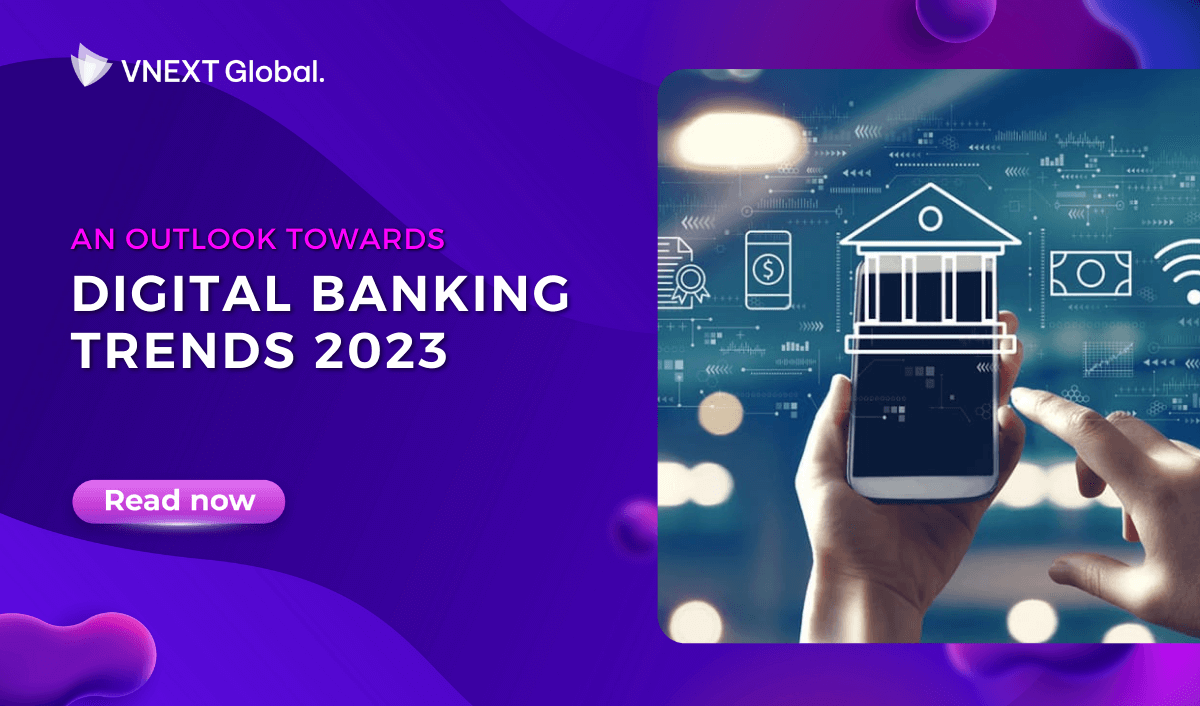Author: Chi Vo - Content Writer
After the pandemic, the banking industry has drastically shifted from physical banking to digital technologies. With the rise of new technologies, digital banking has become the bee's knees for consumers all over the world. As the use of mobile devices continues to skyrocket, banks have had to up their game and pivot towards digital services to keep up with changing customer behavior. In this blog, we will take a closer look at the past and current status of global digital banking, the catalysts that are fostering its growth, and forecast the digital banking trends of 2023. We will also explore how small, medium, and large businesses can benefit from these trends in digital banking. So fasten your seatbelts, and let’s explore the future of digital banking together!
An Outlook Towards Digital Banking Trends 2023
1. The Past and Current Status of Global Digital Banking
The growth of digital banking has been impressive over the last few years. According to a report by Statista, the number of people using digital banking services is expected to reach 216.8 million by 2025, up from 203 million in 2022. In 2021, the global digital banking market was valued at $20.8 billion, and it is projected to grow at a CAGR of 20.5% from 2022 to 2030.
One of the main catalysts for digital banking growth is the rise of mobile devices. According to a report by Statista (Feb 2023), the current number of smartphone users globally is 6.92 billion, which means that 86.34 percent of the world's population owns a smartphone. This has led to an increase in mobile banking, as consumers are now able to access banking services through their mobile devices.
The COVID-19 pandemic has also accelerated the adoption of digital banking. With lockdowns and social distancing measures in place, consumers have turned to online banking services. According to a report by McKinsey, the pandemic has accelerated the digitization of banking by as much as three years.
Another factor driving digital banking growth is changing consumer behavior. Customers are now more inclined to use digital banking services after the pandemic. According to a report by Deloitte, 49% of customers now prefer digital channels for banking. This shift in behavior has prompted banks to adapt their services to meet the needs of customers.
.png)
2. Forecasting Digital Banking Trends in 2023
To quantitatively forecast digital banking trends in 2023, we will conduct a time series analysis. Time series analysis is a statistical technique that is used to analyze trends over time. By analyzing past and current market scenarios, we can make some predictions about the direction digital banking will take over the next few years.
1. The rise of mobile payment
One of the trends in digital banking that we can expect to see in 2023 is the rise of mobile payments. According to a report by Grand View Research, the global mobile payments market is expected to reach $4.5 trillion by 2023, growing at a CAGR of 33.8% from 2020 to 2027. This is a significant increase from the market size in 2019, which was estimated at $1.4 trillion. This growth can be attributed to the increasing adoption of mobile devices and the convenience of mobile payments.
The growth of the mobile payments market presents numerous opportunities for businesses of all sizes. For small businesses, mobile payments can provide a cost-effective way to accept payments from customers without the need for expensive point-of-sale systems. This can help to reduce transaction costs and improve cash flow. In addition, mobile payments can provide a competitive advantage for small businesses, as customers increasingly expect to be able to pay using their mobile devices.
For larger businesses, mobile payments can help to improve customer engagement and loyalty. By offering a convenient and easy-to-use mobile payment option, businesses can provide a better customer experience and build stronger relationships with their customers. In addition, mobile payments can provide businesses with valuable data on customer behavior and preferences, which can be used to improve marketing strategies and product development.
Moreover, mobile payments can also help businesses to expand their reach into new markets. By offering mobile payment options, businesses can more easily reach customers in areas where traditional banking services are less accessible or less prevalent. This can help to improve financial inclusion and support economic development.

2. The use of AI and Machine learning
Another trend that we can expect to see in 2023 is the use of artificial intelligence (AI) and machine learning in digital banking. A report by Grand View Research projects that the global AI in the fintech market will reach $41.16 billion by 2030, expanding at a CAGR of 16.5% from 2022 to 2030. Banks are now using AI and machine learning to improve customer experience, detect fraud, and personalize services. Specifically, with the emergence of advanced AI tools like ChatGPT, it is no surprise that banks are utilizing these technologies to enhance their customer experience.
One way banks are using AI and machine learning is through chatbots. Chatbots are designed to simulate human conversations and can be used to provide customer support, financial advice, and personalized recommendations. In fact, according to a report by Juniper Research, chatbots are expected to save banks over $7.3 billion by 2023. Additionally, they are able to provide 24/7 customer support and assist in a wide range of services, including balance inquiries, transaction details, and money transfers.
Another use of AI and machine learning in digital banking is fraud detection. Traditional fraud detection methods can be time-consuming and ineffective. By using machine learning algorithms, banks can detect fraudulent transactions in real time, reducing the risk of losses for both the bank and the customer. AI and machine learning can also help banks analyze customer behavior to detect unusual patterns, which can help identify potential fraud.
Finally, AI and machine learning can also be used to personalize services for customers. By analyzing data on a customer's spending habits and financial goals, banks can tailor their services to better suit individual needs.
.png)
3. The Emergence of Open Banking
Open banking has been gaining traction in recent years as customers demand more transparency and control over their financial data. In an open banking ecosystem, customers have the freedom to share their financial data with third-party providers who can then analyze the data and offer personalized financial products and services. This allows customers to easily switch between financial products and services that better meet their needs.
Open banking regulations have been implemented in many countries around the world, including the European Union, Australia, and Canada. The implementation of open banking has been driven by the Payment Services Directive 2 (PSD2) in the European Union, which requires banks to share customer data with authorized third-party providers. In Australia, the Consumer Data Right (CDR) requires banks to share customer data with accredited data recipients. In Canada, the government has introduced the open banking review to explore the potential benefits of open banking.
The adoption of open banking is expected to accelerate in 2023 as more countries introduce regulations that require banks to share customer data with third parties. This will create a more competitive and innovative financial services industry, as new players enter the market and offer a range of new services. With open banking, customers will have more control over their financial data and will be able to make more informed decisions about their finances.
.png)
4. Cryptocurrencies and Blockchain Technology
The adoption of cryptocurrencies and blockchain technology is expected to continue to grow in 2023, as banks and financial institutions recognize the potential benefits and explore new use cases. MarketsandMarkets projects that the global blockchain market size will grow from $3 billion in 2020 to $39.7 billion by 2025, at a CAGR of 67.3% during the forecast period.
Banks have been exploring the use of blockchain technology for a variety of purposes, such as international payments and trade finance. For example, in 2020, HSBC completed the first blockchain-based trade finance transaction using the Voltron platform, reducing the time required for processing a letter of credit from five to 24 days down to just 24 hours. By implementing blockchain technology, banks can reduce transaction costs, increase transaction speed, and improve security and transparency.
In addition to the use of blockchain technology, the adoption of cryptocurrencies is also expected to continue to grow in 2023. While the use of cryptocurrencies in day-to-day transactions is still limited, some banks are exploring the use of stablecoins, which are cryptocurrencies that are pegged to the value of a specific asset, such as the US dollar. This allows for the benefits of cryptocurrencies, such as faster and cheaper transactions, while minimizing the volatility that is often associated with cryptocurrencies.
.png)
5. Personalization of Services
The personalization of services is a trend that is expected to take center stage in the digital banking landscape in the coming years. As banks continue to adopt data analytics and AI, they will be able to gain deeper insights into customer behavior and preferences. This will allow banks to offer customized products and services that better meet the unique needs of individual customers.
With personalization, customers will be able to receive tailored recommendations and offers, which will enhance their overall banking experience. For example, a bank could use data to analyze a customer's spending patterns and offer them a credit card with rewards that align with their spending habits. This could include rewards for spending on groceries, dining, or travel, which the bank knows the customer is likely to spend money on based on their transaction history.
Personalization also enables banks to deepen their relationships with customers and improve customer loyalty. By providing tailored solutions that meet each customer's needs, banks can create a more personalized experience that helps them stand out in a crowded market. This, in turn, can lead to greater customer retention and higher customer lifetime value.
In 2023, we can expect to see more banks investing in personalization as a means of gaining a competitive edge in the digital banking landscape. This will require the adoption of advanced data analytics and AI tools to gain deeper insights into customer behavior and preferences. As a result, customers can expect to receive more customized products and services that better meet their unique needs, resulting in an improved banking experience overall.
.png)
3. How Businesses Can Benefit from Digital Banking Trends
To remain competitive and current in the finance industry in 2023, banks have to closely follow digital banking trends. Among the aforementioned trends, cryptocurrencies and blockchain technology stand out as rising stars. Given the rapid development rate of the blockchain industry, it is reckless for banks not to think about switching to cryptocurrency. So how businesses can be beneficial from blockchain and cryptocurrency trends?
- Efficiency and cost-cutting in financial transactions
First and foremost, cryptocurrencies offer a new level of efficiency and cost-effectiveness in financial transactions. Traditional banking systems often involve intermediaries, such as clearinghouses and correspondent banks, which can introduce delays and incur high transaction fees.
In contrast, cryptocurrencies enable direct peer-to-peer transactions without the need for intermediaries, reducing processing time and costs. According to recent data, the average cost of a Bitcoin transaction is significantly lower than traditional methods, making it an attractive option for businesses looking to optimize their financial operations.
- Seamless cross-border transactions
Furthermore, cryptocurrencies provide businesses with a global reach and seamless cross-border transactions. With traditional banking systems, international transactions can be burdened by lengthy processing times, regulatory hurdles, and high fees.
Cryptocurrencies eliminate these barriers by enabling fast and borderless transactions, allowing businesses to expand their customer base and explore new markets without the usual complications. As a result, companies can capitalize on international growth opportunities and simplify their global operations.
- Transparency, security and immutability
Additionally, blockchain technology, which underpins cryptocurrencies, offers unparalleled transparency, security, and immutability. The decentralized nature of blockchain ensures that all transactions are recorded on a distributed ledger, providing a transparent and tamper-proof record of financial activities.
This increased transparency instills trust among customers and stakeholders, as it minimizes the risk of fraudulent activities and enhances accountability. Moreover, the secure nature of blockchain protects sensitive financial data from unauthorized access or cyberattacks, mitigating the risks associated with traditional centralized systems.
- Attract more tech-savvy customers
Embracing digital banking trends also allows businesses to tap into the growing demand for alternative financial services. As more individuals adopt cryptocurrencies and explore decentralized finance (DeFi) solutions, businesses that integrate digital banking technologies position themselves as innovative and customer-centric. By offering cryptocurrency payment options or incorporating blockchain-based solutions, companies can attract tech-savvy customers, gain a competitive edge, and strengthen their brand image as forward-thinking entities.
.png)
4. The Future of Digital Banking: A Digital Transformation to Crypto-friendly Bank, Possible Or Not?
The rising demands in cryptocurrency transactions require digital banking to shift toward to a more crypto-friendly approach. However, rather than completely overhauling your entire business and operations, digital banking can achieve success by embracing innovation and updating its digital banking systems to become more crypto-friendly.
In order to do so, banks need to find a reliable partner in the blockchain sector who not only has various technical experts to develop new functions for your banking system, but also be able to give valuable insights into the blockchain industry. However, it’s hard to find such services that can accommodate all the aforementioned criteria.
With over 15 years of experience in the IT industry, VNEXT Global has established itself as a trusted leader in delivering cutting-edge solutions, with a particular emphasis on the blockchain technology sector. Our extensive experience and expertise make us the go-to partner for businesses seeking innovative IT solutions and valuable advice in the realm of blockchain technology.
Find out more about our blockchain technology services and case studies here!
Final thoughts
Digital banking has become a fundamental aspect of the financial industry, and its growth is expected to continue in 2023 and beyond. With the ongoing pandemic, the shift towards digital banking has accelerated, and banks and financial institutions must adapt to stay relevant in the industry. The integration of new technologies and advancements in security measures will be crucial for digital banking growth and its success in the coming years. For businesses, the adoption of digital banking trends can provide new opportunities for growth and improve customer experience. Hence, don’t wait to jump on the bandwagon, let’s seize the opportunities before they are overtaken by your competitors!
If you are looking for a trusted IT partner, VNEXT Global is the ideal choice. With 14+ years of experience, we surely can help you to optimize your business digitalization within a small budget and short time. Currently, we have 400+ IT consultants and developers in Mobile App, Web App, System Development, Blockchain Development and Testing Services. We have provided solutions to 600+ projects in several industries for clients worldwide. We are willing to become a companion on your way to success. Please tell us when is convenient for you to have an online meeting to discuss this further. Have a nice day!
Author: Chi Vo - Content Writer












